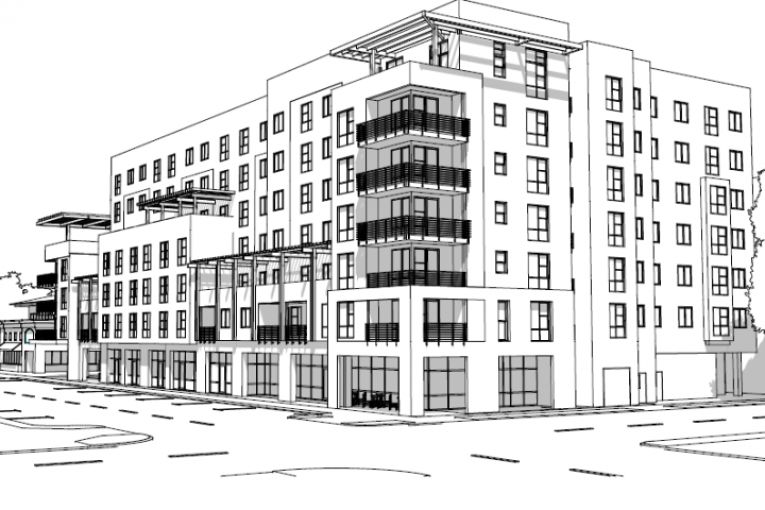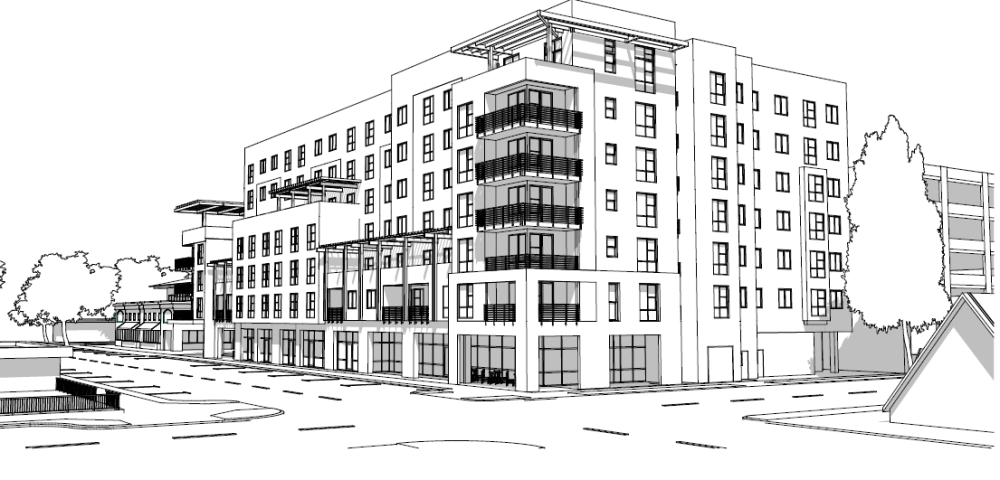

By David M. Greenwald
Executive Editor
Davis, CA – We are still waiting for the Davis Ace project to officially drop, but between that, 4th and G, and the Lumberyards, Davis is looking at 454 units of housing just on the G St. corridor.
The city received the letter from Opterra Law on June 8 but officially posted the project on Monday. The site is filed as a preliminary application pursuant to the Housing Crisis Act of 2019, but also as a Builder’s Remedy project with 20 percent affordable.
According to the letter: “The Project proposes to demolish the existing movie theater, which is no longer in use, and replace it with 114 new apartments, including 20 percent of the units as affordable units for lower income households.”
It’s a mixed-use project as well, including “approximately 3,800 square feet of street-facing retail uses as well as a variety of ground-floor residential amenities including an outdoor plaza, fitness center, and enclosed bike storage.”
The letter notes, “The Project has been designed to fit seamlessly within the existing urban context.”
Because of its proximity to the existing parking garage, the project will not have to build any additional parking. They indicate that “tenants will be able to rent parking spaces as necessary.”
The retail space will remain on the southwestern corner of the project.
The project will include a mix of unit sizes, “including thirty studio apartments, forty 1-bedroom apartments, thirty-two 2-bedroom apartments, and twelve 3- bedroom apartments.”
Twenty-three apartments will be for lower-income households.
Under the Downtown Specific Plan, “The Project complies with the City of Davis (“City”) Downtown Specific Plan and it qualifies for a density bonus pursuant to state law.”
Further, “by including 20% of the units for low-income households, the Project qualifies for two incentives or concessions from local development standards.”
The project as designed, however, “only proposes to use one concession, seeking relief from the maximum height standard.”
The applicant reserves “the right to use the second incentive or concession as may be necessary.”
The letter notes, “We anticipate that the Project application will be reviewed pursuant to the processes articulated by the Specific Plan. Because the Project proposes a new building with an allowed use, it will be subject to staff review upon submission of a complete application and fees.”
Under SB 330, the applicant notes, “By submitting this preliminary application with all of the information specified in SB 330 and a permit processing fee of $10,000 , 5th & G Plaza, Inc. obtains a vested right to develop a housing development project in accordance with the applicable ordinances, policies, and standards in effect as of today’s date, when the preliminary application is submitted.”
Moreover, under the Builder’s Remedy, “Although the City has been working toward compliance with state law, the City’s Housing Element is not yet in compliance according to the April 3, 2023, Letter from HCD to the City.”
In this situation, “a local government cannot deny a housing development for very low, low, or moderate income households unless the local government can make one of five limited findings specified in Government Code section 65589.5(d).”
For the purposes of the Builder’s Remedy, “housing for very low, low, or moderate income households includes a project in which at least 20% of the total units are rented to lower income households, as defined by the Health & Safety Code.”
“This Project includes 20% of the units to be rented to lower income households,” they write. “Therefore, the Builder’s Remedy will apply.”







I wanted to address a few key issues in this comment rather than doing a separate commentary.
First, with the two projects that have dropped their applications and a third project (Davis ACE) that is anticipated, the city will already have 454 units of housing just along G St.
I have been skeptical that the city could get to 1000 by 2029. It’s by no means assured – nor assured that these will get built – there is a good chance I will be wrong here (and frankly I would love nothing more than to be wrong on this).
I think this goes to just how severe the housing crisis actually is, how high the demand for housing in Davis can be. But also it points to the fact that things like the Housing Act Crisis and Builder’s Remedy, actually can work.
The second point will be of course that this project is reaching 20 percent Affordable Housing. That’s perhaps the most shocking part. This project qualifies for Builder’s Remedy, which means the city has no choice but to approve it.
How are they doing that? It has some unique features already including existing infrastructure. It is tapping into the existing parking structure, so they don’t have to deal with parking at all. And the owners of the property own the land outright, which means there is absolutely no land costs. They don’t have to purchase the land and they don’t have to make payments on the land.
The problem with using the G Street Garage is that employees of the US Dept. of Agriculture and nearby restaurant customers also use those parking spaces.
I’ve never seen it more than half full to be honest, and I had to use it for a while a few years ago when they were redoing the alleyway.
The parking garage is private property. The City has a 30 year lease agreement with the owners that is due to expire within the next few years.
The Davis Ace project would be infinitely better if it included the AMTRAK parking lot and all the land in between. Design the structure to provide a welcoming “gateway to Davis” plaza for all the arriving train passengers. Integrate a parking structure into the building so that the number of parking spaces remains unchanged. Residential on all the floors above the street level amenities would more than double the number of residential units/beds.
As noted on the City website,
“Davis Amtrak Access and Connections Study
The City is also engaged in a separate, but related effort for the Davis Amtrak Access and Connections Study. The study seeks to identify opportunities to increase ridership, improve multimodal accessibility, and enhance station safety. In addition, the study will examine the potential benefits of implementing such changes including relieving congestion on local roadways, reducing vehicle miles traveled, and stimulating economic activity downtown. Information is available on the study’s website.”
I meant to say ” if people want to LIVE in downtown… They need to ditch their cars” (with exceptions for ADA and certain trades).
Some technical problem also resulted in my entire comment being italicized… That was not the intention
The Davis Ace project would be infinitely better if it included the AMTRAK parking lot and all the land in between.
I agree. I took a hard look at that property as a potential site for an innovation center when it was about to go on the market, and I came to the same conclusion… Its an opportunity to provide a lot of structure parking in downtown where it might enable outbound amtrak use, and it would be one of the first things you see when coming inbound from amtrak…
I doubt the developer is going to get that aggressive with that site, asking the city to expand onto it’s land…. but I would advocate for exactly the same thing.
There are some details and issues to work on here:
* How many residents at both this place and the two others will actually be car free because of the availability of the 4th Street garage and other possibilities – we should look into restrictions for permits etc based on address….
* 20% low income is still too low, so we should do our best to make it higher.
* Proximity to Pre-K and k to 6 schools/ walkability and bike ability to same (what does the Downtown Plan say about this?).
BUT mainly it’s further evidence of the Dr. Jekyll and Mr. Hyde thing going on in town and the periphery: on the one hand we have automobile oriented things like Village Farms [sic, arguably] and the so far majority council supported I-80 automobile traffic induction sculpture… And all the other we have projects like this.
Let me be clear: it’s not like Coke or Pepsi, or some United Colors of Benetton thing… It’s things that are bad for the climate and bad for street safety vs. structures that respect our climate action plan and increase joy and livability (as long as the parking thing is significantly tightened up.)
Why should there be any resident parking restrictions since the public would also be able park at the G Street Garage? That doesn’t make any sense even if you are a zero vehicle zealot/hypocrite?
Public parking is time-limited; that wouldn’t work very well for resident parking.
The rules could be different on different levels of the structure.
Yay – more student housing
(Never mind – it’s for all of the “professional baristas” working downtown.)
Number one rule for a college town – do not build any housing that a student could possibly move into.
Not 😂
define “college town”. City of Davis? Nope. Hey, let’s support a billion dollar institution! On deck! The State of California! In the hole; Kaiser Permanente (the next largest employer in the region).
Keith E, I suspect you’re the only person in this town who believes that statement. A “college town” is NOT defined in any legal manner–it is entirely a de facto situation defined by the proximity of a college to the environs of the town. If they are contiguous, it is a “college town.”
There are lots of people living in Davis who have nothing to do with the university.
I suspect your’re the only person ANYWHERE who believes that residents of Davis “owe” the university anything.
In fact, most of them already had to pay a PREMIUM – due to the presence of the adjacent university. Perhaps the university should reimburse them for that!
So it’s your position that college towns don’t actually exist?
David: Who is your question directed toward?
As far as “college towns”, they’re probably all a mixture (not strictly devoted to an adjacent college). This is an informal term which has no specific meaning.
Davis is part of the broader Sacramento region.
Ask someone outside of the state where “Davis” is, vs. “Sacramento”. In fact, ask them where the nearest large city to UCD is located.
Watch the movie “Lady Bird”, if you think that UCD is strictly associated with Davis.
And while you’re at it, ask them about “North, North Davis”.
Or ask them where the UCD Medical Center and (future) Aggie Square are located. (Though they probably wouldn’t know the answer to either of those questions.)
In any case, there’s LOTS of Davis residents who have nothing to do with UCD. Some work in Sacramento or elsewhere, some are retired, etc.
I can tell you that I don’t think of San Luis Obispo, Santa Barbara, or Santa Cruz as “college towns” (off the top of my head). Nor Berkeley, strictly speaking. Nor Los Angeles, San Francisco, Arcata, Sacramento . . .
Chico? Sort of. Then again, it was the “college party town”, from what I recall.
I informally think of Davis as something “in-between” a college town vs. a suburb of Sacramento.
I don’t really want to dive into the rabbit hole… don’t agree, don’t want to get into this side discussion.
PLEASE lets not play the “can we reduce it by one floor” game with this proposal PLEASE???
We need this kind of housing SO bad, that I would question them if they could ADD a floor if anything…
As I understand it, this is by right. There is absolutely no discretion here.
Look up the term “opportunity cost.”
Thank you Jim. David’s comment is a bit myopic.
The concept of no parking with the high density proposals is not only short sighted, but it is ridiculous. First, this would be the way to wipe out our downtown retail, which is one of our City’s major source of tax revenue. So if you want to kill the downtown retail, imposing no parking in these high density proposals is the way to do it. Davis does not have the robust transit system needed to eliminate or even reduce parking. The downtown doesn’t have enough parking now, so how is creating more parking need by eliminating the parking for these vertical mixed-use projects supposed to work? They would need to make the train station parking multi-story parking before even considering either of these vertical mixed-use project which would cost the City (i.e. Davis residents) a fortune.
Second, if you think people are going to pay high rents and have no parking, that is just a fairy tale. Otherwise, this will just become another version of mega-dorm housing with the pooling of rents from multiple students living in the downtown, which is not helping alleviate our need for housing for our workers and families.
Further, well gee, it sure looks like vertical mixed-use can be done with more than 5% affordable housing if motivated. So, there needs to be a mandatory affordable housing for vertical mixed-use for not just 5% (which is currently only “recommended”, but for at least 10%-15% affordable housing in our City’s affordable housing ordinance. Vertical mixed-use needs to do its “fair share” of affordable housing and not continue being a loophole for affordable housing, as it has been for decades.
“The concept of no parking with the high density proposals is not only short sighted, but it is ridiculous. ”
It’s interesting because that goes against the thinking of modern urban planning at this point. First, it ignores the reality of climate change. Second, parking requirements jack up the cost of housing.
The same “planning” which has pushed people out of San Francisco toward suburban sprawl.
Assumes that the impact of climate change will be “less” (see point #1).
When developers don’t mitigate the costs of their proposal – see both comments, above.
And truth be told, new residents either pay those costs themselves, or transfer their impacts to the surrounding neighborhood. (To the folks who had to “pay” for their own impacts, a long time ago.)
A megadorm, by any other name.
I fully support privileged students, their parents (or any other potential new resident) paying the full cost of their impacts. If they don’t, someone else will be forced to do so.
Have you ever noticed that the International students (those who pay “full tuition costs”) do not seem to be among those claiming that someone else “owes” them something?
And third, these projects bring retail customers downtown so that they don’t need to drive! And fourth, the distance from any of these projects to the train station is quite surmountable for someone of working age.
If we’re going to reach our climate mitigation goals, we’re going to need these types of projects that get people out of their cars.
Note that 20% affordable is likely attainable in this situation because there is no land transfer and any increases in property taxes likely will be constrained in comparison. Because the owner will capture the future rents directly, the land cost is basically the original cost.
Thereby replacing existing customers who do drive.
Making it more difficult for existing Amtrak users to park anywhere – thereby encouraging THEM to drive for their entire trip!
See a “pattern”, here?
None of them “get people out of their cars”. They add new people, who may have cars of their own.
If you want to get “people out of their cars”, stop advocating for proposals like DISC, or the sprawling proposals outside of city limits. This isn’t rocket science.
The only reason for this proposal is because it’s a megadorm, by any other name. As is the one at Hibberts.
With BOTH of the proposals “replacing” businesses that actually served the community.
What are you talking about? Are you claiming that they would they live in the existing ACE building?
Ron O
Downtown Davis retail is struggling, but you may not have noticed since you don’t live here.
How does walking to the Amtrak station from 5th and G displace other Amtrak riders? I’m missing a major logic step here.
These projects will have fewer cars per household compared to other developments, especially other developments that would be built instead in other communities to meet this housing demand. And those cars will be driven less being downtown. (My own car use dropped more than two-thirds when we moved closer to Downtown.) I don’t know how this project has any relationship to DiSC, nor do I see how building commercial development somewhere other than Davis gets people out of their cars. Again, there’s a major logic step missing here.
OK, yet another misdefinition. Please provide a rigorous definition of a “megadorm” that is applicable across all multi-household housing projects. I’m pretty sure that like your definition of “sprawl” that it will be meaningless in its lack of details.
The 4th & G project is replacing a closed movie theatre, and the Hibbert project is replacing a closed hardware store, neither of which will be reopened. In addition, these projects appear to be including ground floor retail.
A building owner, who is often the developer, collects rents from tenants which is income accruing to the property. When a landowner sells to the developer, the landowner captures a portion of that future rent as an upfront payment. But if the owner and the developer is the same entity then there’s no transaction with an upfront sales payment. There’s no recorded sale to be taxed or to trigger reassessment.
Actually, Richard – I’ve never discussed where I live or what connection I have to Davis. Nor do I ever plan to do so.
I “probably” don’t live in San Francisco (unlike a certain UCD professor, who apparently commutes from there while constantly advocating on behalf of YIMBYism), but that doesn’t stop me from reading about the struggles they have there – including the loss of Nordstrom, and how Westfield is now pulling out as well.
Actually, San Francisco’s entire downtown (retail AND office space) is a disaster, right now. Some are referring to it as a “doom loop”.
But Davis is fortunate that University Mall landed Nordstrom Rack – which wouldn’t have happened if the city continued messing with that mall owner’s plans. As it is, they’ve already delayed those plans (and impacted revenue for the city).
If parking and congestion is made more difficult, this isn’t a difficult concept to grasp.
Are you comparing this to a campus development? If so, your conclusion is faulty.
What “happens in Davis, doesn’t stay in Davis”.
There’s certainly a step missing in logic or cohesiveness regarding whatever point you’re supposedly trying to make.
I’ll admit that I’m using the word “megadorm” very loosely, here – to describe a proposal that will be primarily student housing. And wouldn’t exist with demand from students.
I don’t know what “4th and G” project you’re referring to, but I already miss Hibbert’s – as well as the ACE Housewares store.
And I truly doubt that any ground floor retail (appealing to students living “upstairs”) will hold much interest for existing Davis residents.
Really? I had “no idea” that rent is paid to a building owner who rents out their property.
That’s just a a completely false statement. There is no rent collected at point of sale. For that matter, there’s no “agreement” between a seller and a buyer regarding how a property might be used after sale.
Right – owners typically don’t pay themselves to continue owning land. Your point?
Dude, there’s a reassessment when a new building is built. You didn’t know that? And why is this important, anyway?
Ron O
I’ve pointed out based on your appearances before various Woodland public bodies and your quotes in the Woodland Daily Democrat [edited] that you live in Woodland. You don’t need to tell us this on this forum–you’ve already publicly proclaimed in other media outlets. The Vanguard forum doesn’t exist in isolation of the rest of the world. You’ve been very public about where you live.
Not sure why San Francisco is relevant to Davis. The fact is that most of those SF residents moved to other Bay Area communities, many of which have thriving downtown retail.
Again, how do pedestrians walking to the Amtrak station create parking and congestion problems? You’re being illogical.
Why would I compare housing for workers and seniors in Davis to campus development? Of course, I’m comparing it to development pushed to other cities, so my conclusion is well supported.
Huh?
You have failed to make a connection between DISC and these projects. Trying to assert that I’m being illogical without explaining your logic doesn’t answer the question.
If you’re going to use the term “megadorm”, you need to show why ALL projects proposed that might house students are “megadorms.” This is similar to your broad misuse of the term “sprawl.” You make words meaningless in your sloppiness.
Again, Hibbert isn’t coming back and neither is the Ace housewares store. So how are these businesses being “displaced” if they no longer exist?
I don’t understand you’re point about rent.
You clearly don’t understand the economics of land valuation. Land value is set by the income that is generated on that land. That’s a fundamental fact of commercial real estate. A seller has a pretty good idea of what the buyer is using the land for, especially with zoning.
You’re missing the point about reassessment under Prop 13 that can vastly increase property taxes by multiples. That’s why the rents for businesses in downtown Davis went up so much when that family sold properties a few years ago. Most importantly, the land value is not reassessed when a new building is built–only the improvements. Land value can be the majority of the total value.
Ron O
You have been quite public about your residency in Woodland. You can’t hide from that here.
Retail isn’t declining everywhere. The business press has been noting the rise in many places, but often in different forms. Again generalizing from San Francisco to Davis isn’t appropriate.
My original comment was in response to a specific comment saying that the Hibbert and ACE sites would increase congestion at the Amtrak station.
Again, how would pedestrians going to the station from these locations increase congestion at the Amtrak station? (Don’t change the subject.)
Where’s your evidence that these projects wouldn’t exist without student demand? The target populations described in these proposals don’t appear to include students, and the market rate rents are pricey for students. Students are unlikely to qualify for the Affordable units.
I explicitly deny DiSC’s net contribution to regional GHG emissions. The appropriate calculation must net out the emission offset from displaced developments elsewhere. Ignoring that displacement is not an appropriate analysis frame.
Again again you’re not using the defintion of “sprawl” appropriately. Please see the authoritative definition that I posted twice before. You’re not the sole authority on setting definitions of relevant terms.
Nothing about “missing” these businesses-you said “replaced” in a context that can only be interpreted at displacing.
Again, you’re denying what you said before, written in black & white.
Jim Frame’s response has nothing to do with how land prices are established, only about a proportion of value attributable to land. (I responded to him and I don’t know which parcel he’s referring to.) My point is still unrefuted on how sales values are established.
If this project and the Hibbert site get developed as proposed, it would be a huge boon to the Davis Food Coop and might finally revitalize that shopping center.
As a fully-invested partial “owner” of the Co-Op, I can tell you that it’s doing just fine serving existing customers like me. There is no “problem” to be fixed via pursuit of growth, there.
Nor do I support efforts to drive owner/investors like me out, to accommodate customers which don’t even exist at this point.
Your type of advocacy is exactly what’s “wrong” with the entire capitalistic system. Never satisfied, and always a fake shortage of (fill-in-the-blank). Must be an incredibly empty feeling, to always want “more”.
This type of belief is what led to the rise of some Co-Ops in the first place. It seems that some have lost all of the values that arose during the 1960s and its aftermath.
Sad, actually. But probably predictable.
And in its “place” – “identity politics”, I guess. Along with a complete disconnect between pursuit of growth and environmental impacts.
Ron O
You must go to different Coop owner meetings than I do. The board is always concerned about losing market share and declining sales. It has taken several initiatives to increase sales to be more financially stable.
And yet, I just received an email that they installed a brand-new roof.
Tell you what – put me on the board, and I won’t be advocating for a new development, regardless.
Ron O
Putting you on the Coop board would be a major mistake because you’ve clearly demonstrated that you don’t understand finances sufficiently.
The Assessor tracks building permits, and will reassess upon completion. We’ve remodeled our house four times, and the Assessor got in touch at least twice (maybe all four times, I don’t remember).
The assessor only reassesses the addition, not the value of the land which is a major portion of the total value.
If by “major portion” you mean 12% (the current fraction of the assessed value represented by the land), then, yeah.
Which parcel are you talking about? Yours or 4th & G? For our house land is about half of the assessed value. When conducting a study of property values in the Delta region for commercial properties, Yolo County land value is 30% of total assessed value.
I haven’t “proclaimed” anything. You have, after looking up and referencing articles in which my residence wasn’t even “reported”. For that matter, I wasn’t even aware of the article, until YOU posted links to it.
And one reason why I haven’t is because it’s irrelevant. You can probably assume I have a connection to Davis – which is also irrelevant.
You’re clearly NOT concerned about “where” commenters on here live, or else you’d be mentioning this in regard to several other commenters on here.
You didn’t realize retail was declining? Have you ever heard of Amazon? (Of course, in San Francisco, there’s far more going on than that – including an exodus of businesses, drug dealing in the streets, etc.) “Doom Loop”, as some have called it.
Now, you’re just being purposefully dense. Are you claiming that everyone who would live at Hibbert’s or ACE sites would not use motor vehicles? Or their visitors, or deliveries?
These proposals wouldn’t even exist, without the demand created by students.
This is also the reason that the RHNA targets will fail where there “aren’t” enough students to justify investment.
Your comment was related to local contributions to climate change, right?
Well, DISC was about the biggest contributor to local contributions to climate change that’s ever been proposed for Davis.
Do you deny that?
Also, do you deny that the other sprawling proposals (the 400-acre Covell Village II, Shriner’s, 100% Housing DISC, and whatever that thing is proposed on the south side of I-80 is not a contributor to greenhouse gasses?
I don’t “need” to do jack.
Did I say they were displaced? Oh right – that’s the word that YOU used. I said that they are “missed” (and served the EXISTING population). Thought one might argue that they were indeed “displaced” due to UCD’s failure (going back decades) to address the demand that it created.
See Jim Frame’s response, above.
Ignore Commenter
420 G Street.
Assessor land values are not reflective of current land values in my humble opinion.
They’re not really meant to be, the Assessor discounts the land value as a matter of policy (or so I was told long ago). The valuation of improvements, on the other hand, is generally kept a little low but still connected to market value. The valuation of a new building will generate a big bump in the tax bill regardless of the land valuation.